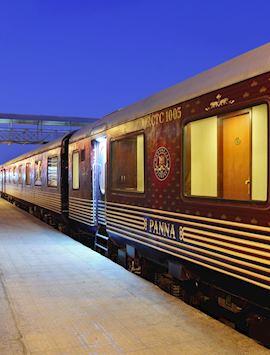By Audley India specialist Alison
Living and working in Mumbai for a number of years, I spent weekends exploring my surroundings by hopping on local trains, sleeper trains and toy trains. In a country that relies on its rail network like no other, it’s little surprise that a range of luxury trains is available for you to tour India from a different perspective.
Choosing to travel in India by luxury train

Join a luxury train tour across India, and you’ll cover more ground than you could by car. You’ll be able to visit far more places and, as most trains travel during the night, won’t feel rushed.
Tours and activities are usually conducted in small groups, and dinners are enjoyed together with your fellow passengers. I’d agree that this wouldn’t suit the more independently minded, but if you’re keen for a little more privacy, some trains provide complimentary private tours if you book a suite or presidential cabin.
Luxury trains in India
The Maharajas' Express

Completing its maiden journey in 2010, the Maharajas' Express is the newest and, in my opinion, most luxurious train running in India. Cabins range from the well-sized deluxe to suites with their own private sitting area. There’s even a presidential suite pulled in its own carriage.
Teak doors separate your cabin from the corridor, and rooms are decorated with Indian prints and brass trim. Beds are positioned along the length of the train — I could hardly feel any movement as I slept.
The majority of meals are eaten on board. Almost everything, from the croissants at breakfast to the handmade chocolates at dinner, is made from scratch. As we sat down to each meal, the head chef, John Stone, would make his way down the carriage, talking to guests about the food and explaining the finer points of some of the Indian dishes. Hailing from Shimla, he likes to include dishes popular with his family on the comprehensive continental menu.
Maharajas' Express train routes

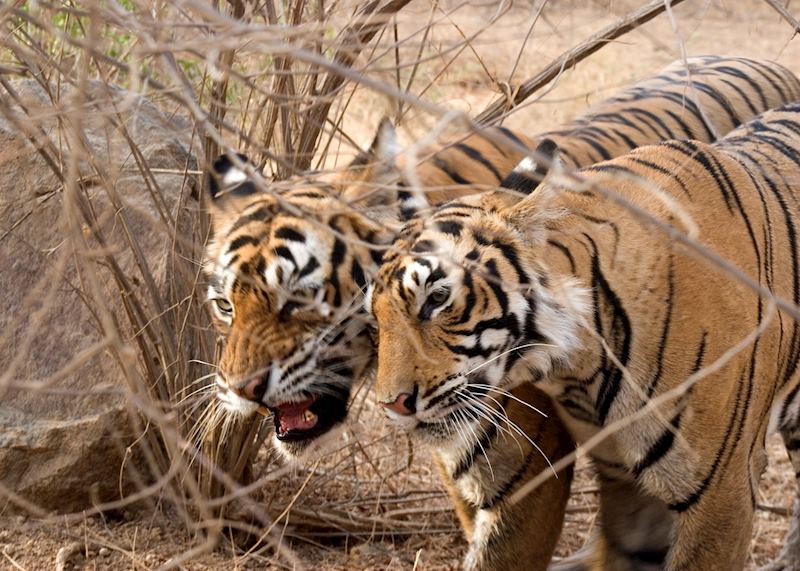
Five different routes all focus on the northern state of Rajasthan and its surrounding areas, with journeys ranging from three to six nights. I experienced the shortest tour: Treasures of India. Taking just three nights, it’s an ideal taste of luxury train travel without committing to the cost of the longer tours.
I was driven from my Delhi hotel to Safdarjung Railway Station in the southern suburbs of the city. Joining my fellow guests on board, brunch was served as the train set off past housing blocks strung with bright lines of washing and green patches of park. Our first stop was Agra.
It’s difficult to miss the Maharajas' Express as it pulls into a station. Its cherry-red body is decorated with gold patterns, and it’s by far the cleanest train. As it arrived into Agra, local musicians announced our arrival on the platform. I stepped off onto a red carpet to receive a welcoming flower garland. This, I was told, is the protocol for every stop.
Coaches branded with the train’s insignia are the mode of transport for touring Agra. Tours are in groups, but you have headphones to listen to the guide, who speaks through a microphone.
The first day in Agra focuses on visiting its calling card, the Taj Mahal. After an early start and a guided tour, you have time to take photographs and relax in the surrounding gardens.
You go back to the train for lunch, then set out again in the afternoon to tour Agra Fort, home of the Mughal emperors. It’s possible to stand where Shah Jahan, the creator of the Taj Mahal, was imprisoned by his son, within view of his masterpiece. You then return to the train for dinner, and depart for Ranthambhore National Park.
From the train, we drove by 4x4 into the park. We’d been warned that the tigers in Ranthambhore were elusive, and we’d be lucky to glimpse a dash of tail. While we were peering into the bushes at a sambar deer, a female tiger casually walked out in front of us. Everyone suddenly went silent as we watched her nonchalantly survey her territory.


You close your cabin curtains that evening on scraggly jungle and open them the next morning to a cityscape crammed with flat-topped apartments and open-faced shops: Jaipur.
It’s a jeep ride up to Amber Fort, overlooking the surrounding Aravalli Hills. The tour of the fort guides you through a maze of palace rooms and courtyards, culminating in a visit to the Sheesh Mahal, or ‘chamber of mirrors’. This room is covered by so many gems, mirrors and pieces of painted glass it can be lit by a single candle.
The Express’s itineraries include exclusive experiences it wouldn’t be possible to book otherwise. In Jaipur, we were granted access to Jaipur’s royal family’s private quarters of the City Palace. Entertainment was provided in the gardens before we were taken up to their rooftop terrace for a dinner with views across the city. I managed to glimpse at a few royal rooms along the way.
On the final morning, you awake in Delhi to disembark after a substantial breakfast. The Express’s routes begin or end in Delhi but don’t usually include visiting any of its sites. Although it’s noisy and chaotic, I wouldn’t discount spending a few nights in Delhi before you catch the train. A guided city tour will give a taster of what’s to come.
Palace on Wheels

The Palace on Wheels feels a little dated, but that’s part of its charm. One of the first luxury trains dedicated to leisure — those that came before were for royalty or dignitaries — it started running in 1982. The General Manager then is still running the train now. On my first night aboard, we were given a short talk on the history of the train: as a passenger, there’s a real sense of becoming part of its heritage.
The train is made up of 14 saloon coaches, each named after a place on the route. On the coach named Kishangarh, a village noted for its Bani Thani miniature paintings, local artists have painted examples of their work. There are also two restaurants, a lounge car and four service cars for staff.
Four cabins fit into each saloon and share a small lounge. Two valets are assigned to each saloon — Opi and Rasjish who looked after me were always keen to recommend their pick of the day’s menu. The deluxe cabins are clad in polished teak and have sash windows and wall hangings. Upgrade to the presidential suite and you’ll also get a private sitting area.
Palace on Wheels route
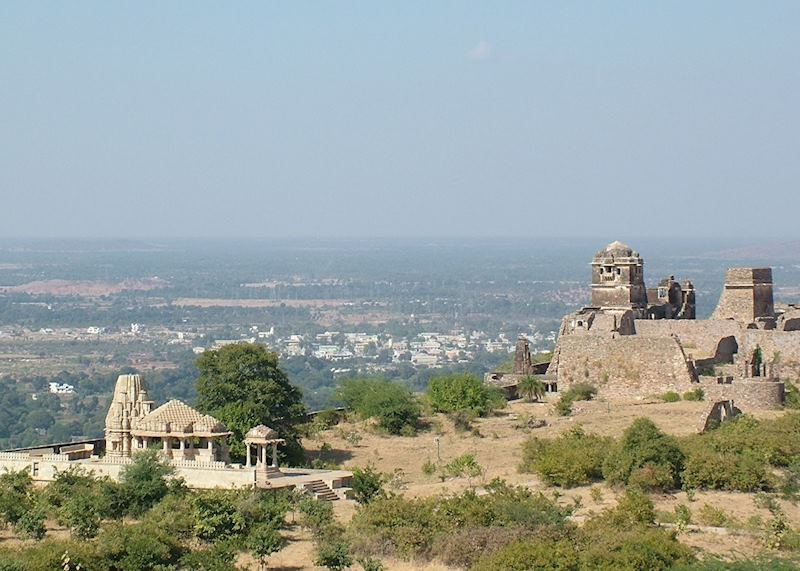

Departing every Wednesday, the Palace on Wheels follows a set seven night route across north India. For me, the range of wildlife, key highlights and more offbeat rural areas it covers makes it one of the most comprehensive insights into India. Journeying long distances as you sleep, the train halves the amount of time it would take to complete this trip by car.
Arriving at Delhi Railway Station, I boarded the train in the evening, ready for dinner. Food is a white-gloved, silver-service affair. Service can feel a little slow, but this doesn’t seem to matter when you’re surrounded by gilded mirrors and printed wallpaper. With set dining times, you’ll eat alongside your fellow guests each night.
The first few days of the route, visit the fortress city of Jaipur and Ranthambhore National Park. The train then delves further into Rajasthan, starting with Chittorgarh, a fortress town built by the Rajputs, a prominent Indian ruling family.
Look at a map and you’ll find that Chittorgarh is surrounded by nothing but the odd tiny hamlet. A long drive from the nearest city and with only a couple of very basic hotels, it’s rarely visited. After touring the fort — the largest in India — we settled down to watch the evening’s sound and light show. The fort walls are lit with a succession of moving lights as a voice narrates the history of Chittorgarh.
After dinner on board, the train then continues south to Udaipur. A greener city, Udaipur is set around two lakes, protected by the Aravalli Hills. The Lake Palace sits in the middle of Lake Pichola, a once pleasure palace for a young Mughal prince. It’s now one of the most luxurious hotels in the world. It isn’t usually possible to visit unless you stay at the hotel, but as train passengers we had the opportunity to dine there.
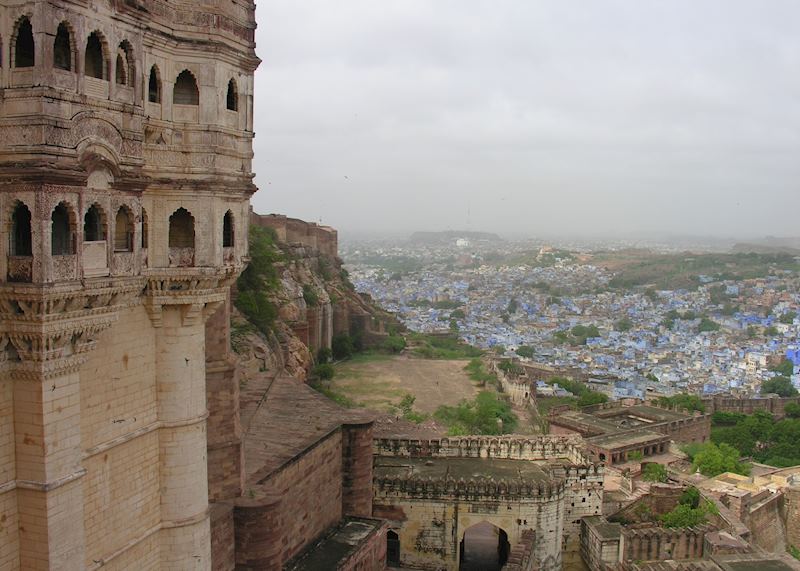

The fortress city of Jaisalmer, which marks the gateway to the Thar Desert in Rajasthan, has no airport and is a dusty seven-hour drive from the nearest city. As part of the Palace on Wheels route, you wake there after an overnight ride from Udaipur. Jaisalmer’s fort is the only lived-in example in India, and a guided tour takes you past local schools, temples and shops squeezed in between the military and palace buildings.
The train then begins its journey back toward Delhi, stopping in Jodhpur, India’s blue city, before heading onward to Bharatpur. Here you’ll visit Ghana National Park, flourishing wetlands that protect thousands of nesting birds. It’s a key route for migratory birds, and you’ll often see Sarus cranes, egrets and waterfowl.
The train’s finale is a visit to Agra and the Taj Mahal, before returning you to Delhi.
The Deccan Odyssey

The Maharashtra Tourist Board conceived the Deccan Odyssey train as a way to encourage visitors to explore alternative, less-visited parts of India. States such as Maharashtra and the Deccan in central India were difficult to travel through, even for the most determined, with few hotels, guides or roads. Setting up a train service swiftly solved the problem.
Running since 2004, the train has been fully refurbished recently. Its light, airy cabins are now furnished with locally sourced fabrics. You’ll find the wooden furniture, under close scrutiny, is veneered rather than carved wood, but everything is clean and fresh. There are two dining cars, a lounge, a spa and a small gym.
Two deluxe cabins occupy each car, with a butler per car providing a personal service. The service on board is very attentive — I enjoyed tea in my cabin each morning — and you’re given a mobile phone preloaded with your butler’s number.
I couldn’t fault the food served on board, enjoying racks of lamb, a traditional Indian thali and far too many desserts. The dishes are beautifully presented, and the chefs take a real pride in their cooking, walking along the dining cars to check how their dishes have been received.
Deccan Odyssey routes
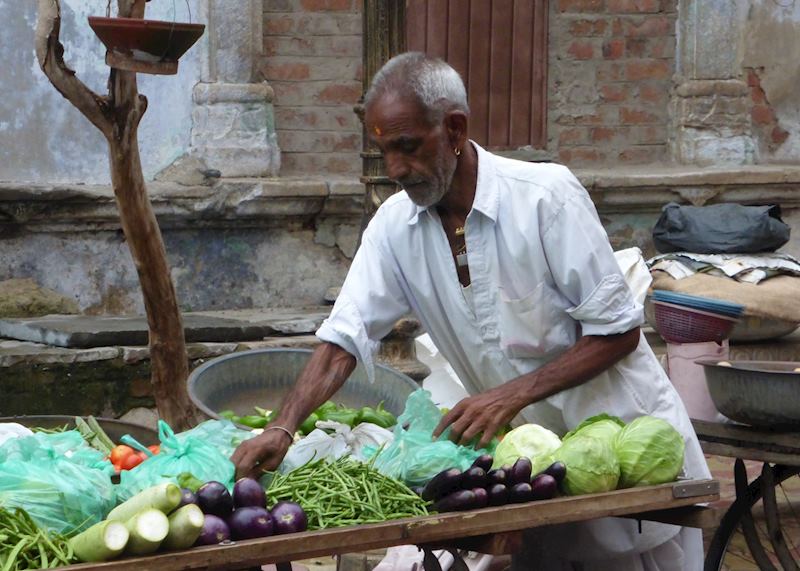

Each of the Deccan Odyssey’s six routes is focused on a hard-to-travel-in part of India. The seven-night Central India route is by far the most leisurely way to reach the remote ancient monuments at Hampi. But, it’s the seven-night Hidden Treasures of Gujarat route which particularly appeals, as it journeys from Mumbai into the rarely visited northwest state of Gujarat.
Touring through Gujarat, you won’t cross big-name sites off your list, but you will see a part of India that has changed very little. In this predominantly tribal state, you’ll be welcomed into the villages of the Agarias and Rabari tribes. Little is known about these farming communities who live on the outskirts of the Rann of Kutch, the largest salt marsh in the world and an otherworldly glowing white landscape stretching as far as you can see.
The salt marsh is slowly being encroached on by the Gir National Park, the last surviving habitat of the Asiatic lion. Slightly smaller than their African counterparts, Asiatic lions have a shorter mane and are speckled with black, giving them an almost silvery tone. As part of the train’s tour, you can take a safari into the park to track the lions; although they’re notoriously cautious, sightings are common.
Completing a circular route back to Mumbai, the train stops at Hindu and Jain temple sites as well as workshops where you can see some of the state’s textile production. Gujarat silk is well-known as one of the finest fabrics produced in India, made into sarees hand-woven with intricate patterns and a popular Indian wedding attire.
Extending your trip

Most of India’s luxury train journeys finish in Delhi or Mumbai, making it easy to extend your trip by jumping on a short flight. If you’re looking for some time to relax, Goa is a direct flight from either city.
You won’t find pristine white-sand beaches but exotic dark-gold sands, dotted with fishing boats, cafés and craft markets. Panjim, now known simply as Goa’s Old Town, was once the capital of the Portuguese Estado da India (State of India). Streets of Portuguese townhouses have been recently restored and painted bright yellow and pink, mango and papaya trees growing out front.
Start planning your luxury train trip through India
Start thinking about your experience. These itineraries are simply suggestions for how you could enjoy some of the same experiences as our specialists. They're just for inspiration, because your trip will be created around your particular tastes.
View All Tours in India
